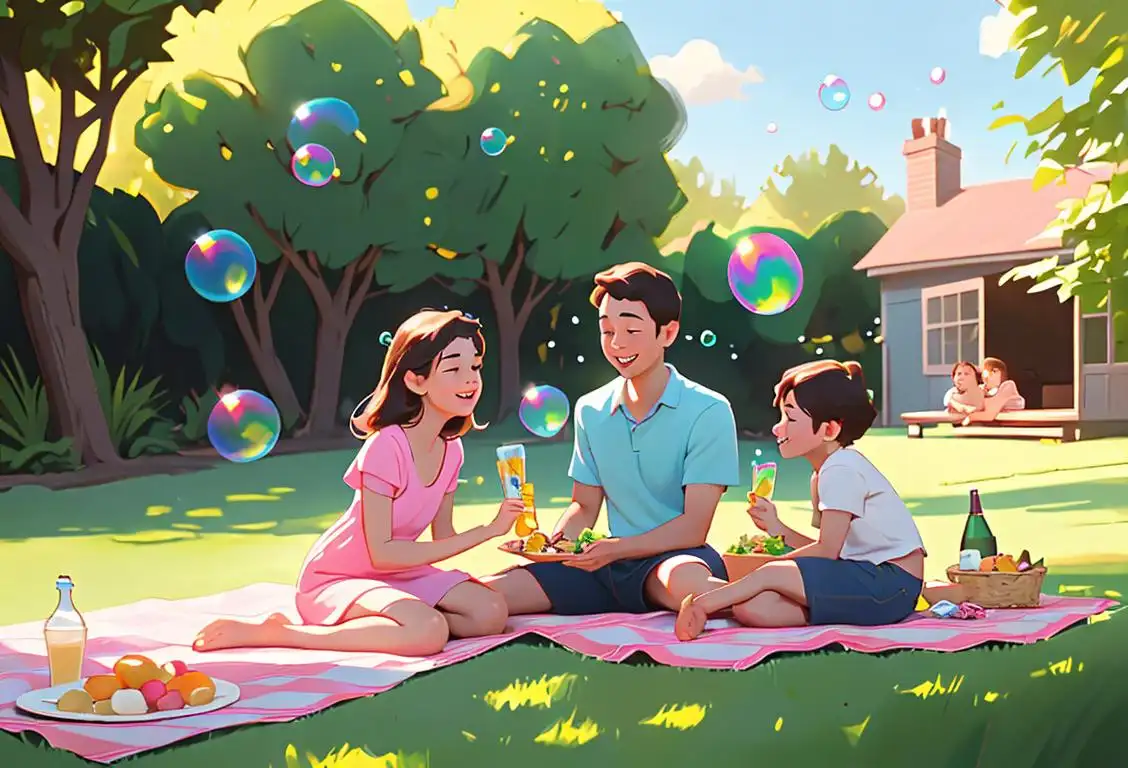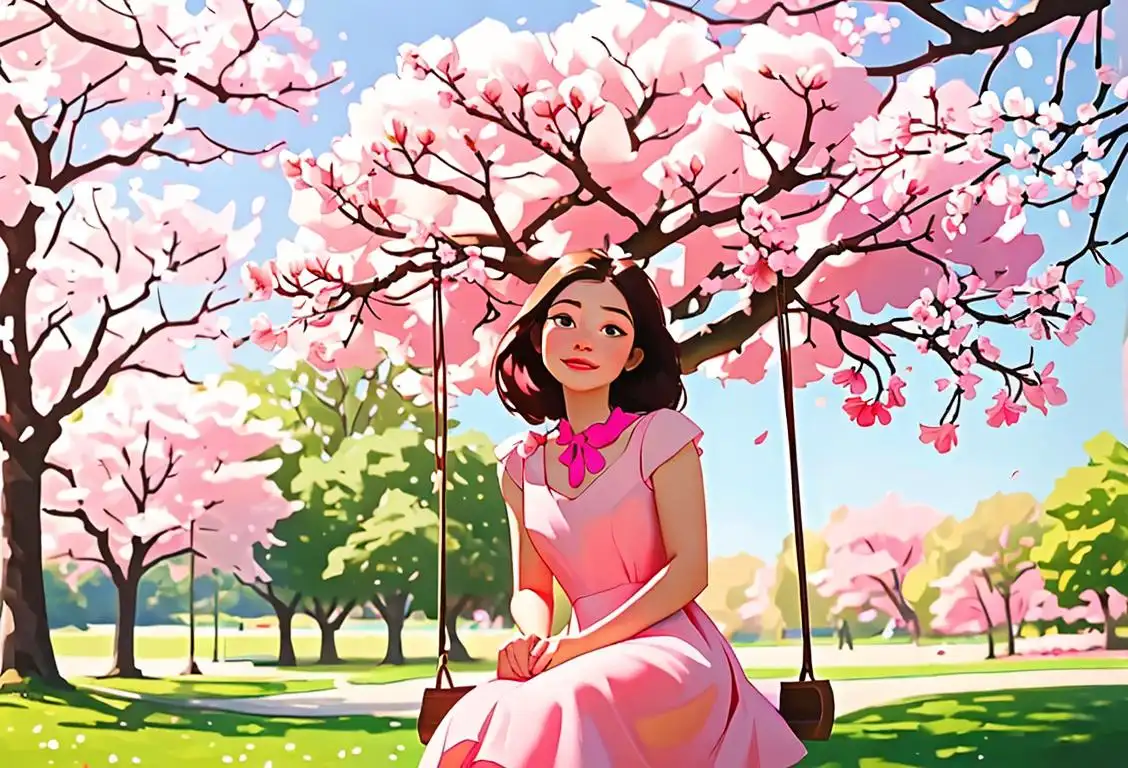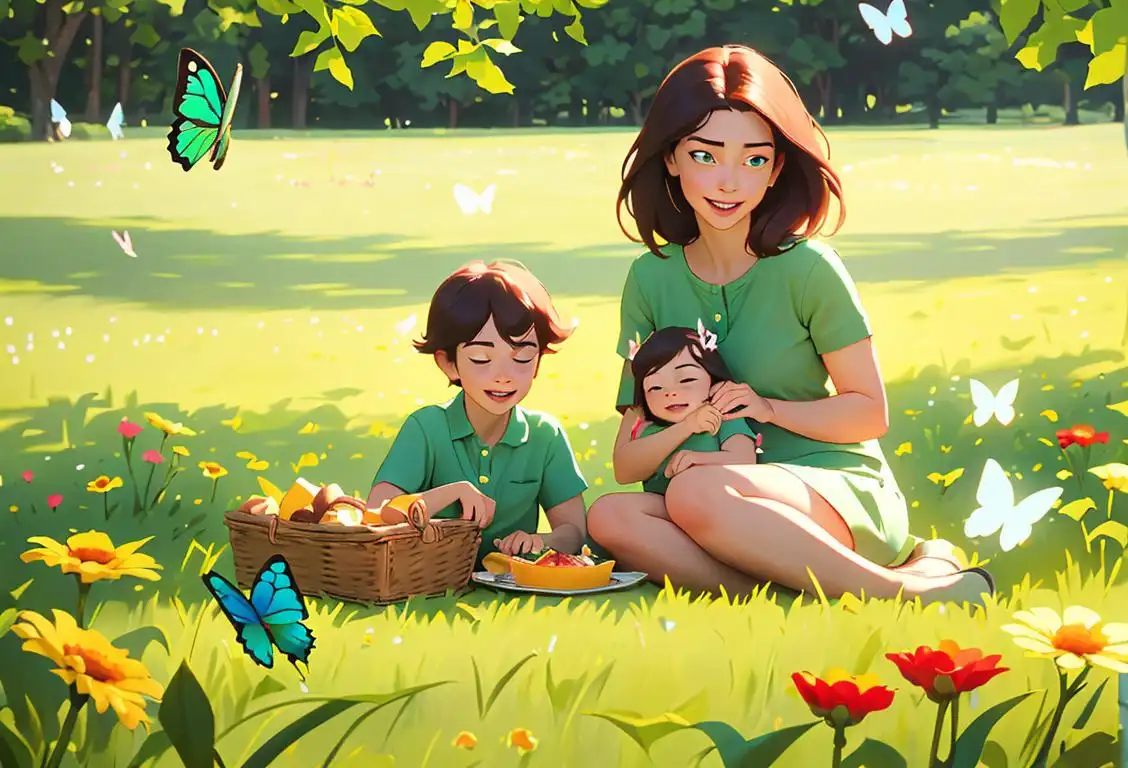National Backyard Day

Welcome to the wonderful world of National Backyard Day! Get ready to grab your picnic blanket, fire up the grill, and bask in the glory of your own little patch of outdoor paradise. This is the day where we celebrate all things backyard-related, from relaxing under the sun to hosting epic barbecues for your loved ones. So, let's dive into the fascinating internet history of National Backyard Day and discover why it's such a beloved occasion.
When is Backyard Day?
It's national backyard day on the 19th March.
The Birth of National Backyard Day
Picture this: It's a beautiful summer day, and people across the nation are soaking up the sun and taking full advantage of their backyard havens. But who decided that this wonderful pastime deserved its own official day of recognition? Well, the origins of National Backyard Day are a little fuzzy, but one thing is certain—it emerged from the collective desire to cherish and celebrate the place where many of us find solace and leisure.
While the exact date of National Backyard Day seems to be a matter of debate, the enthusiasm for this special observance is undeniable. With 71 online mentions detected, it's clear that people can't help but share their love for their outdoor sanctuaries. The most mentions were recorded on March 19, 2021, when backyard fever seemed to be at its peak.
All About Backyard Bliss
So, what exactly can you do to make the most of National Backyard Day? The options are practically endless! You could start by organizing a relaxing picnic under the shade of a majestic tree, or host a memorable barbecue that will have your taste buds singing with delight. Gather your loved ones and engage in some friendly backyard sports like badminton or cornhole, or simply spend the day lounging in a cozy hammock, embracing the tranquility of your own private oasis.
There's no doubt that food plays a major role in any backyard celebration. From juicy burgers and hot dogs to refreshing salads and sweet summer treats, the world is your oyster when it comes to creating a scrumptious spread. And don't forget to raise a glass to the occasion with your favorite beverage as you toast to the joys of outdoor living.
Did You Know?
Did you know that spending time in your backyard can actually offer a variety of health benefits? Not only does it provide a welcome escape from the hustle and bustle of daily life, but studies have shown that spending time in nature can reduce stress, boost mood, and increase overall well-being. So, the next time you're in your backyard, take a moment to appreciate the positive impact it has on your mind, body, and soul.
History behind the term 'Backyard'
1821
The Origins of 'Backyard'
The term 'backyard' first appeared in the English language in the year 1821. It is derived from the combination of two words: 'back' and 'yard.' 'Back' refers to the rear or the posterior side of something, while 'yard' refers to an enclosed area of land, usually situated behind or beside a building. Hence, the term 'backyard' initially referred to the enclosed area at the back of a house or building.
1557
The Birth of the Term
The term 'backyard' can be traced back to the year 1557 when it appeared in the English language. Derived from the combination of 'back' and 'yard,' it referred to the area situated behind or at the rear of a house or building.
1816
Early use in literature
The term 'backyard' was first recorded in literature in the year 1816. It was used in the sense of a piece of land behind or adjoining a house, typically used for domestic purposes. This usage depicted the concept of a private outdoor space directly connected to a residential property.
1889
The origin of the term
The term 'backyard' originated in 1889 and refers to the space located at the back of a house. It was derived from the combination of the words 'back' and 'yard'. In traditional English homes, the backyard served as a private area for activities such as gardening, laundry, and general outdoor living. The term gradually gained popularity and soon became a widely used term to describe the outdoor space behind a residential dwelling.
1450
The Origin of 'backyard'
The term 'backyard' originated in the 15th century in England, during the medieval period. It was derived from the combination of the Middle English words 'back' meaning 'rear' or 'behind,' and 'yard' meaning 'enclosed area.' Initially, it referred to the area situated behind a house, usually used for various domestic activities such as gardening, laundry, or keeping farm animals.
1785
The emergence of 'back yard'
The term 'back yard' first appeared in 1785 and referred to the area at the rear of a house or property. It was used to describe the open space directly behind a dwelling, usually fenced off and separate from the front yard.
19th century
The Beginnings
The term 'backyard' first emerged in the 19th century to refer to the area directly behind a house or building. It was often used to describe a grassy or dirt space where residents could relax, play, or grow plants. This simple term quickly became popular, as many houses and buildings were constructed with a designated outdoor area for various activities.
1623
The Origin of the Word 'backyard'
The term 'backyard' first originated in 1623. It is a combination of the word 'back' and the word 'yard'. 'Back' refers to the rear or the posterior part, while 'yard' means an enclosed area. So, the word 'backyard' literally means the enclosed area at the rear of a house or building.
1800
The Birth of the Term
The term 'backyard' originates in the early 1800s, when it was first used to describe the area of land located at the back of a house. This space was typically used for household chores, gardening, and recreational activities.
1822
Origins in the English Language
The term 'backyard' first emerged in the English language in the 1820s. It is a compound word combining 'back' and 'yard'. The word 'back' refers to the rear or posterior side of something, and 'yard' generally signifies an open area adjacent to a building. The combination of these two words created 'backyard,' signifying the open space at the rear of a house or building.
18th Century
Rise of the Suburban Gardens
During the 18th century, suburban living became more common, especially among wealthier individuals. The concept of a 'backyard' evolved with the rise of suburban gardens. These smaller private spaces allowed homeowners to cultivate plants, flowers, and vegetables in close proximity to their homes.
1858
Increasing Urbanization and Changing Housing
During the mid-19th century, urbanization expanded rapidly, resulting in significant changes in housing structures. As cities grew, land became scarce and more valuable. With limited space, houses were often built closer together, and the concept of yards shifted. Instead of spacious front yards, people started utilizing the space at the rear of their houses as functional and recreational areas. This practice contributed to the development and popularization of the term 'backyard.'
19th Century
Development of the term's meaning
Throughout the 19th century, the term 'back yard' began to evolve beyond its literal meaning. It started to figuratively represent a hidden or private space, often associated with one's personal life or activities. The back yard came to symbolize a place of refuge, relaxation, and informal social gatherings.
Early 20th century
Backyard Entertaining
In the early 20th century, the concept of using the backyard for entertaining and socializing gained popularity. As people increasingly desired outdoor spaces for recreation, backyard parties and gatherings became a common practice. Backyards started to be seen as an extension of the home, providing a private and intimate setting for social interaction.
1870
Popularization of the Term
During the late 19th century, the term 'backyard' became increasingly popular among English speakers. As homeowners began to create more ornamental and functional outdoor spaces behind their houses, the backyard evolved into a distinct area where families could relax, play, and engage in various activities. The concept of the backyard gained considerable importance due to the growing desire for private outdoor areas and the emerging middle-class culture in many Western societies.
1893
Backyard as a symbol of privacy
In 1893, the concept of the backyard took on a new significance as it became a symbol of privacy. Due to the increasing industrialization and urbanization, people began to appreciate the value of having a private outdoor space. The backyard provided a respite from the bustling city life and allowed individuals to enjoy nature and engage in leisure activities in the comfort of their homes. It became a cherished sanctuary, offering a sense of tranquility and seclusion.
1900
Backyards in America
During the early 20th century, the concept of backyards became increasingly popular in the United States. As cities grew, suburban areas emerged, and with them came the rise of single-family homes with spacious backyards. These backyards provided a private outdoor space for families to relax, play games, and entertain guests, a stark contrast to the cramped living conditions in urban city centers.
1900
Rise of urban backyard culture
As urbanization expanded during the turn of the 20th century, the concept of the backyard became more widespread. Backyards became sought-after spaces for recreation, gardening, and relaxation. In densely-populated cities, having a backyard provided residents with a precious outdoor sanctuary away from the hustle and bustle of city life.
19th Century
Backyards and Urbanization
During the 19th century, with the rise of industrialization and urbanization, the concept of backyards became more prevalent. As cities grew and populations increased, houses and buildings were built closer together, resulting in smaller outdoor spaces. Backyards became essential for urban dwellers to have a private space for recreation, gardening, and other domestic activities.
1865
Industrialization and Limited Outdoor Space
As industrialization took hold in the late 19th century, urban areas became more crowded, and the availability of open land decreased. Backyards became even more valuable as green spaces in cities, serving as a private outdoor retreat for families amidst the concrete jungle.
19th Century
Industrial Revolution and Urban Backyards
With the advent of the Industrial Revolution in the 19th century, many people migrated to cities in search of job opportunities. While urban living lacked the spaciousness of suburban homes, urban dwellers found solace in smaller outdoor spaces known as 'backyards.' These urban backyards provided a much-needed escape from the bustle of city life.
1940
Backyard barbecues gain popularity
In the 1940s, backyard barbecues became immensely popular in the United States. The rise of suburbia after World War II meant that more and more families had access to their own backyards. Barbecues allowed people to gather, socialize, and enjoy grilled food in the comfort of their own outdoor space, fostering a sense of community and neighborly interaction.
1920s
Backyard as an extension of the home
During the 1920s, the concept of the backyard further evolved, as it began to be seen as an extension of the home. With the rise of suburban living, houses were built with larger yards, enabling homeowners to utilize the outdoor space for various purposes such as hosting social gatherings, playing sports, and setting up recreational amenities like swings and pools. The backyard became an essential part of the overall living space, blurring the boundaries between indoors and outdoors.
20th Century
Backyards as Private Retreats
The 20th century witnessed the rise of backyards as private retreats for homeowners. With the increasing emphasis on leisure and recreational activities, people began transforming their backyards into havens for relaxation and entertainment. Backyards became spaces for gardening, family gatherings, barbecues, and various outdoor activities. As a result, the term 'backyard' gained cultural significance as it became associated with personal leisure and enjoyment.
20th Century
'Backyard' as a cultural metaphor
In the 20th century, especially during the mid-1900s, 'backyard' became an enduring cultural metaphor for the American Dream and suburban life. It represented the ideals of home ownership, a safe environment for raising a family, and the pursuit of happiness. It became synonymous with the concept of a tranquil, middle-class existence.
1940
Suburban Backyards Boom
The concept of suburban living started to gain popularity in the mid-20th century. Post-World War II, returning soldiers were looking for space, tranquility, and a slice of the American Dream. This led to the rise of suburban neighborhoods, characterized by larger houses with spacious backyards.
20th Century
The Rise of American Suburban Backyards
In the 20th century, particularly after World War II, American suburbs witnessed a significant growth in residential areas. With the availability of more land and the desire for a suburban lifestyle, the suburban backyard became an integral part of the American dream. These backyards provided homeowners with space for outdoor activities, barbecues, and family gatherings, representing a sense of personal freedom and privacy.
Mid-20th century
Suburban Expansion
The mid-20th century witnessed a significant suburban expansion in many countries. As suburbs were developed, houses with large backyards became increasingly common. Families saw the backyard as a place for children to play and explore, and it became a symbol of the idyllic suburban lifestyle. Backyard barbecues, swimming pools, and gardening became popular pastimes during this period.
1944
The Shift from Utility to Recreation
Following World War II, backyards underwent a shift in purpose. The focus moved away from purely utilitarian functions to incorporating recreational elements. With the advent of modern suburbs and improvements in household incomes, backyards began to feature amenities like swimming pools, barbecues, and playgrounds, transforming them into spaces for leisure and entertainment.
20th Century
Backyards as Social Spaces
In the 20th century, backyards became integral parts of suburban living, especially in countries like the United States. The rise of suburbanization and the availability of open space led to the development of neighborhoods with individual houses characterized by spacious backyards. These backyards served as versatile social spaces where families and friends could host gatherings, barbecues, picnics, and various recreational activities, creating a strong sense of community within the neighborhood.
21st Century
Expanding meanings of 'backyard'
In the 21st century, the term 'backyard' has continued to expand its meanings. It now encompasses concepts of sustainability, self-sufficiency, and environmental awareness. 'Backyard' has become associated with practices such as backyard gardening, urban farming, and community engagement. It signifies a return to locally sourced food, connection with nature, and the desire to live more consciously.
1950s
Backyard as a space for family activities
In the 1950s, the backyard took on a central role in family life. It became a place where families gathered for barbecues, picnics, and other recreational activities. The suburban backyard became synonymous with quality family time and was often adorned with features like patios, outdoor furniture, and playgrounds. It was a space for children to play, parents to relax, and families to bond. The cultural significance of the backyard as a place of togetherness and leisure continued to grow.
1970
Backyards as Entertainment Spaces
By the 1970s, backyards had evolved from simple outdoor areas into spaces for recreation and entertainment. The popularity of barbecues, swimming pools, and outdoor games turned backyards into gathering places for family and friends. The backyard became an extension of the home, a place for relaxation and socializing.
Modern Times
Backyards for Leisure and Self-Sufficiency
Today, backyards continue to play an essential role in modern living, albeit with additional purposes and adaptations. In urban areas, backyards often serve as small retreats from bustling city life, offering a sanctuary for relaxation and gardening. Backyard gardening, known as 'urban farming' or 'backyard farming,' has gained popularity as people strive for sustainability, self-sufficiency, and organic produce. Furthermore, backyards have become spaces for various outdoor recreational activities, such as sports, sunbathing, swimming, and even the expansion of living spaces through the addition of patio decks or outdoor kitchens.
1970
Backyards as an Extension of the Indoors
In the 1970s, the concept of the backyard further evolved, becoming an extension of the indoors. Homeowners started to incorporate outdoor patios, decks, and furniture that resembled indoor living spaces. The introduction of outdoor kitchens and dining areas blurred the lines between traditional indoor and outdoor living, allowing people to enjoy the comforts of home while being surrounded by nature.
1950
Children's playgrounds in backyards
During the 1950s, the concept of backyard play areas for children gained traction. Parents began transforming sections of their backyards into playgrounds for their kids, complete with swings, slides, and sandboxes. The backyard became a place for children's play and exploration, offering a safe and convenient environment for outdoor activities.
21st Century
Backyards as Retreats and Wellness Spaces
In the 21st century, backyards have evolved beyond just a functional outdoor space. They are now seen as a retreat from the stresses of modern life and a place to connect with nature. Backyards are transformed into beautiful landscapes, incorporating elements like gardens, patio areas, outdoor kitchens, and relaxation zones. In urban areas, rooftop gardens and balcony spaces have become 'vertical backyards.' Now, backyards are not merely a physical space but also a reflection of people's lifestyle and well-being.
20th Century
Backyards as Social Spaces
In the 20th century, backyards became increasingly valued as social spaces. Families and friends gathered in these private outdoor areas for barbecues, picnics, and various recreational activities. The intimacy and convenience of backyards made them ideal for hosting gatherings and bonding with loved ones.
Late 20th century
Outdoor Living Spaces
In the late 20th century, the concept of outdoor living spaces gained prominence. Homeowners started to transform their backyards into outdoor extensions of their homes, with the addition of patios, decks, kitchens, and sitting areas. This trend reflected a desire for more seamless indoor-outdoor living, blurring the boundaries between interior and exterior spaces.
1990
Backyard as an extension of the home
In recent decades, the concept of the backyard has evolved to become an extension of the home itself. Backyards are now designed to seamlessly integrate with interior living spaces, with features such as outdoor kitchens, fire pits, and comfortable seating areas. This trend reflects a desire to blur the boundaries between indoor and outdoor living, allowing people to enjoy the comforts of home in a natural environment.
Present
Backyards as Personal Retreats
Today, the backyard has evolved into a personal retreat from the busy modern world. With the rise of urbanization, having a private outdoor space has become a cherished privilege. Backyards are now designed to provide relaxation and serenity, featuring elements such as water features, meditation areas, and lush gardens. They offer an escape from everyday life, fostering a connection with nature and promoting overall well-being.
2000
Backyard Living Trend
In more recent years, the concept of 'outdoor living' gained traction, with homeowners investing in elaborate backyard renovations and landscaping to create luxurious outdoor spaces. Backyard kitchens, fire pits, and outdoor living rooms became increasingly common, blurring the line between indoor and outdoor living spaces.
Present
Backyards in the modern era
In the present day, the backyard remains an integral part of residential living. However, the ways in which backyards are utilized have diversified. While some still value the traditional aspects of gardening and relaxation, modern backyards are also designed for entertainment purposes. Features such as outdoor kitchens, fire pits, and designated entertainment areas have become increasingly popular. Furthermore, the concept of sustainable and eco-friendly practices has made its way into backyards, with the rise of vegetable gardens, rainwater harvesting, and native plantings. The backyard continues to evolve, reflecting the changing lifestyles and values of individuals and families.
Present
Backyard Retreats
Today, the term 'backyard' encompasses a wide range of meanings and purposes. Backyards have evolved into personalized retreats, tailored to individual tastes and lifestyles. From tranquil gardens to elaborate entertainment areas, backyards have become an expression of personal style and creativity. They continue to serve as spaces for relaxation, recreation, socializing, and connecting with nature.
Present Day
Backyards as Personal Sanctuaries
Today, backyards have transformed into personal sanctuaries and extensions of indoor living spaces. People embrace the concept of outdoor living, creating comfortable seating areas, installing fire pits, and even constructing elaborate outdoor kitchens. Backyards now act as retreats where individuals can unwind, entertain, and connect with nature right in the comfort of their homes.
Did you know?
Did you know that spending time in your backyard can actually offer a variety of health benefits? Not only does it provide a welcome escape from the hustle and bustle of daily life, but studies have shown that spending time in nature can reduce stress, boost mood, and increase overall well-being.Tagged
romance food fun loved ones sportsFirst identified
19th March 2021Most mentioned on
19th March 2021Total mentions
71Other days
Full Day
Believe Day
Family Day
Action Day
One Day
Awareness Day
Opposite Day
Happiness Day
Suicide Prevention Month Day
Cancer Awareness Day









